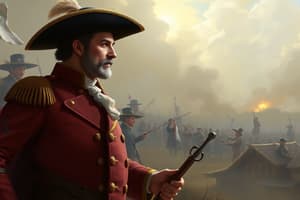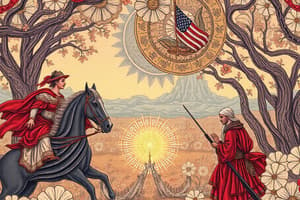Podcast
Questions and Answers
What was one significant effect of the Treaty of Guadalupe Hidalgo?
What was one significant effect of the Treaty of Guadalupe Hidalgo?
- It ceded California and other territories to the United States. (correct)
- It led to the immediate end of the Mexican-American War.
- It provided financial compensation to Mexico.
- It outlawed slavery in all U.S. territories.
Which event is most closely associated with heightened sectionalism between the North and South?
Which event is most closely associated with heightened sectionalism between the North and South?
- The Texas Annexation
- The Wilmot Proviso
- The Compromise of 1850
- The Panic of 1857 (correct)
Who was the main proponent of the compromise that included the outlawing of slave trade in Washington D.C.?
Who was the main proponent of the compromise that included the outlawing of slave trade in Washington D.C.?
- Stephen Douglas
- James K. Polk
- Abraham Lincoln
- Henry Clay (correct)
What was one reason President Polk sought the acquisition of California?
What was one reason President Polk sought the acquisition of California?
What concept was promoted by the Wilmot Proviso?
What concept was promoted by the Wilmot Proviso?
Which action was a result of the Compromise of 1850?
Which action was a result of the Compromise of 1850?
What was one outcome of the Mexican-American War?
What was one outcome of the Mexican-American War?
Which act allowed for popular sovereignty in Kansas and resulted in violent conflict?
Which act allowed for popular sovereignty in Kansas and resulted in violent conflict?
What was the primary concern for Irish immigrants during the mid-19th century in the U.S.?
What was the primary concern for Irish immigrants during the mid-19th century in the U.S.?
What document stated that slavery should not be allowed in new territories?
What document stated that slavery should not be allowed in new territories?
Which president is associated with the phrase 'Fifty-Four Forty or Fight!'?
Which president is associated with the phrase 'Fifty-Four Forty or Fight!'?
What event is often highlighted as a significant sign of sectional conflict over slavery?
What event is often highlighted as a significant sign of sectional conflict over slavery?
Which statement accurately reflects Lincoln's position when he first became president?
Which statement accurately reflects Lincoln's position when he first became president?
What idea fueled the notion of Manifest Destiny in the 19th century?
What idea fueled the notion of Manifest Destiny in the 19th century?
What was significant about the Lecompton Constitution?
What was significant about the Lecompton Constitution?
Flashcards
Mexican-American War
Mexican-American War
A conflict between the US and Mexico from 1846 to 1848 over territorial disputes.
Tensions from Texas Annexation
Tensions from Texas Annexation
Political and social strains resulting from Texas joining the US in 1845, angering Mexico.
Treaty of Guadalupe Hidalgo
Treaty of Guadalupe Hidalgo
The 1848 agreement that ended the Mexican-American War, giving US land for $15 million.
Wilmot Proviso
Wilmot Proviso
Signup and view all the flashcards
Compromise of 1850
Compromise of 1850
Signup and view all the flashcards
California became a free state
California became a free state
Signup and view all the flashcards
Fugitive Slave Act
Fugitive Slave Act
Signup and view all the flashcards
Popular sovereignty
Popular sovereignty
Signup and view all the flashcards
Bleeding Kansas
Bleeding Kansas
Signup and view all the flashcards
Dred Scott Decision
Dred Scott Decision
Signup and view all the flashcards
Harper's Ferry Raid
Harper's Ferry Raid
Signup and view all the flashcards
Election of 1860
Election of 1860
Signup and view all the flashcards
Impending Crisis of the South
Impending Crisis of the South
Signup and view all the flashcards
Texas Border Dispute
Texas Border Dispute
Signup and view all the flashcards
Study Notes
Mexican-American War (1846-1848)
- Causes:
- Tensions from the annexation of Texas.
- President Polk's desire for California.
- Border dispute between Mexico and the US.
- Effects:
- Treaty of Guadalupe Hidalgo: US acquired Mexican territory (California) for $15 million.
- Heightened tensions over slavery.
- Wilmot Proviso proposed to prevent the expansion of slavery into new territories.
- Increased sectionalism between North and South.
Compromise of 1850
- Key provisions:
- Outlawed the slave trade in Washington D.C.
- California admitted as a free state.
- Settled the Texas border dispute.
- Utah and New Mexico territories adopted popular sovereignty regarding slavery.
- Fugitive Slave Act.
- Impact:
- Further fueled tensions between North and South.
- Sparked resistance and disobedience to the Fugitive Slave Act in the North.
Leading to the Civil War
- Political changes: Lowered property and voting restrictions broadened the electorate, requiring presidents to appeal to a broader population.
- Westward expansion: Expansion resulted in the creation of current US borders.
- Immigration: A surge in European immigrants, including Chinese, prompted immigration restrictions and citizenship debates.
Manifest Destiny
- Polk's campaign: Polk utilized Manifest Destiny in his presidential campaign to gain popular support.
- Slogan: "Fifty-Four Forty or Fight!" reflected American demands for the Oregon border.
Mexican-American War Effects
- Territorial Gain: US acquired considerable territory, including present-day California, Nevada, New Mexico, Arizona, Utah, parts of Colorado, and Wyoming.
- California Gold Rush: The discovery of gold in California spurred a massive migration and influenced trade with Asia.
- Slavery Question: The acquisition of new territories ignited debate regarding the expansion of slavery.
- Mexican Citizenship: Citizenship was offered to Mexicans in the newly acquired lands.
- Native American Impact: The expansion negatively affected Native American populations due to westward migration.
- Wilmot Proviso: Legislation that proposed preventing the expansion of slavery into newly acquired territories.
- Zachary Taylor: Became famous due to his role in the war.
Sectional Conflicts and Regional Differences
- Irish Immigration: Primarily settled in New York and Boston, faced discrimination due to their Catholic faith.
- Free Soil Movement: Irish immigrants often supported the free-soil movement, opposing the expansion of slavery, and concerned about job competition.
- Nativism: Anti-immigrant sentiment surged.
- Abolitionist Literature and Sentiment: Harriet Beecher Stowe's Uncle Tom's Cabin fueled Northern opposition to slavery. Works by Hinton Helper also examined the damaging effects of slavery on poor whites.
No More Compromise
- Election of 1852: The Whig Party fractured due to internal disagreements over slavery.
- Franklin Pierce (Democrat): Succeeded in the Presidency.
- Kansas-Nebraska Act: Overturned the Missouri Compromise, enabling popular sovereignty in Kansas for slavery.
- Bleeding Kansas: Violent conflicts erupted over the issue of slavery in Kansas.
- Sumner-Brooks Affair: The physical assault in Congress highlighted the intense polarization over slavery.
- James Buchanan (President): Failed to effectively address the escalating tensions.
- Lecompton Constitution: A proposed Kansas state constitution that attempted to incorporate slavery in a roundabout way, but failed to gain congressional approval.
- Dred Scott Decision: The Supreme Court case denied citizenship to Dred Scott and re-ignited the slavery debate
Election of 1860 and Secession
- Lincoln's Election: Abraham Lincoln (Republican) won the presidency, promoting the anti-expansion of slavery stance.
- Initial goal: Lincoln's primary goal was to preserve the Union, NOT abolish slavery.
- Harpers Ferry: John Brown's failed raid further radicalized opinions. John Brown's raid and execution galvanized supporters on both sides of the issue of slavery.
Studying That Suits You
Use AI to generate personalized quizzes and flashcards to suit your learning preferences.




